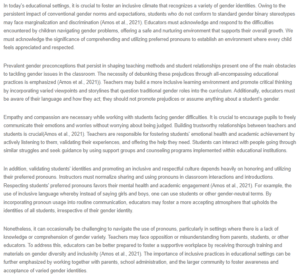Peer Response – Gender Issues in the Classroom
Hello,
Thank you for your contribution to the discussion. I agree that educators have a crucial role in fostering an effective learning environment to support and address the needs of each student. Some students have gender issues, which is a significant threat to their academic performance. Following this, educators must provide ways to mitigate gender issues in the classroom to encourage an effective learning atmosphere. Educators should use inclusive teacher strategies that steer students’ participation through developing a sense of belonging (Amos, 2021). Understanding the students is essential in resolving gender issues in the learning environment. Therefore, teachers should use inclusive pronouns when referring to the class, such as the term students rather than girls and boys. Resolving gender issues calls for promoting inclusive practices in education, achieved through collaboration among all stakeholders to identify the issues. Gender issues are a significant threat to the student’s academic success, where some students feel disrespected and unaccepted in the learning environment. Do you need urgent assignment help ? Our homework help will you tons of energy and time required for your homework papers.
References
Amos, S. N., Latz, A. O., & Mulvihill, T. M. (2021). Implementing Gender Inclusive Housing: A Narrative Inquiry. College Student Affairs Journal, 39(1), 43–58. Retrieved from https://muse.jhu.edu/pub/288/article/786873/summary
ORDER A PLAGIARISM-FREE PAPER HERE
We’ll write everything from scratch
Question

Peer Response – Gender Issues in the Classroom
In today’s educational settings, it is crucial to foster an inclusive climate that recognizes a variety of gender identities. Owing to the persistent impact of conventional gender norms and expectations, students who do not conform to standard gender binary stereotypes may face marginalization and discrimination (Amos et al., 2021). Educators must acknowledge and respond to the difficulties encountered by children navigating gender problems, offering a safe and nurturing environment that supports their overall growth. We must acknowledge the significance of comprehending and utilizing preferred pronouns to establish an environment where every child feels appreciated and respected.
Prevalent gender preconceptions that persist in shaping teaching methods and student relationships present one of the main obstacles to tackling gender issues in the classroom. The necessity of debunking these prejudices through all-encompassing educational practices is emphasized (Amos et al., 2021)). Teachers may build a more inclusive learning environment and promote critical thinking by incorporating varied viewpoints and storylines that question traditional gender roles into the curriculum. Additionally, educators must be aware of their language and how they act; they should not promote prejudices or assume anything about a student’s gender.
Empathy and compassion are necessary while working with students facing gender difficulties. It is crucial to encourage pupils to freely communicate their emotions and worries without worrying about being judged. Building trustworthy relationships between teachers and students is crucial(Amos et al., 2021). Teachers are responsible for fostering students’ emotional health and academic achievement by actively listening to them, validating their experiences, and offering the help they need. Students can interact with people going through similar struggles and seek guidance by using support groups and counseling programs implemented within educational institutions.
In addition, validating students’ identities and promoting an inclusive and respectful culture depends heavily on honoring and utilizing their preferred pronouns. Instructors must normalize sharing and using pronouns in classroom interactions and introductions. Respecting students’ preferred pronouns favors their mental health and academic engagement (Amos et al., 2021). For example, the use of inclusive language whereby instead of saying girls and boys, one can use students or other gender-neutral terms. By incorporating pronoun usage into routine communication, educators may foster a more accepting atmosphere that upholds the identities of all students, irrespective of their gender identity.
Nonetheless, it can occasionally be challenging to navigate the use of pronouns, particularly in settings where there is a lack of knowledge or comprehension of gender variety. Teachers may face opposition or misunderstanding from parents, students, or other educators. To address this, educators can be better prepared to foster a supportive workplace by receiving thorough training and materials on gender diversity and inclusivity (Amos et al., 2021). The importance of inclusive practices in educational settings can be further emphasized by working together with parents, school administration, and the larger community to foster awareness and acceptance of varied gender identities.
As a result, resolving gender issues in the classroom calls for a multimodal strategy that includes encouraging the use of preferred pronouns, fostering supportive relationships, and reforming the curriculum. Teachers have a significant role in developing an inclusive classroom that values diversity and gives every student a feeling of community (Amos et al.,2021). Teachers may help create a more fair and supportive learning environment where students feel empowered to accept their identities and realize their full potential by promoting empathy, normalizing preferred pronouns, and challenging gender stereotypes.
References
Amos, S. N., Latz, A. O., & Mulvihill, T. M. (2021). Implementing Gender-Inclusive Housing: A Narrative Inquiry. College Student Affairs Journal, 39(1), 43–58. Retrieved from https://muse.jhu.edu/pub/288/article/786873/summary

